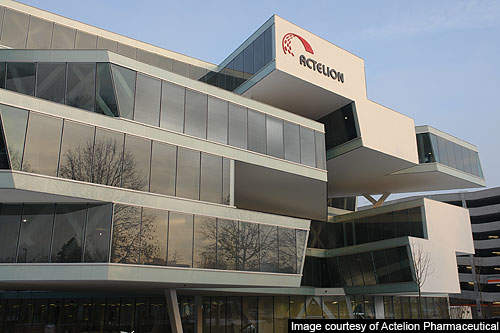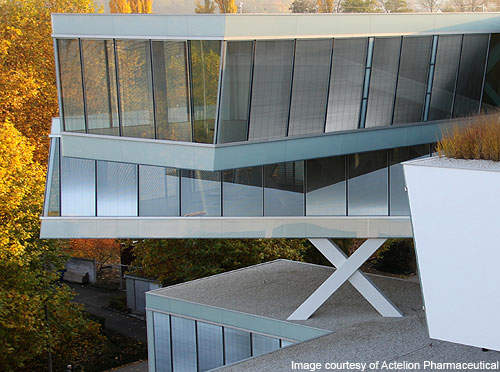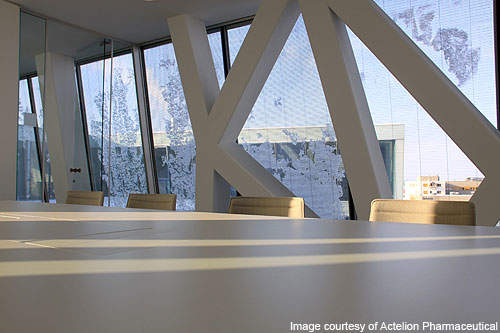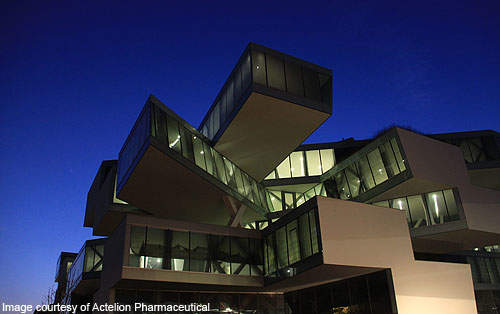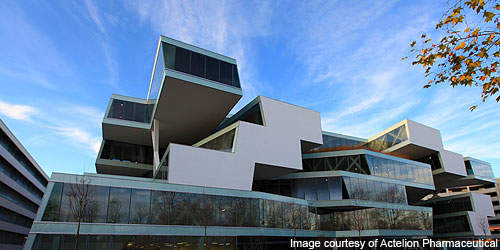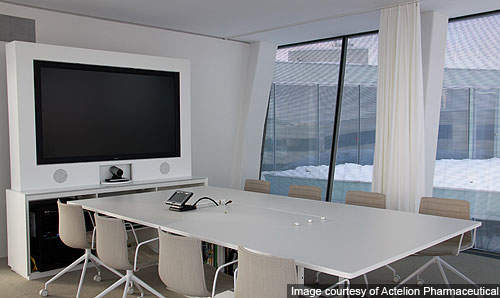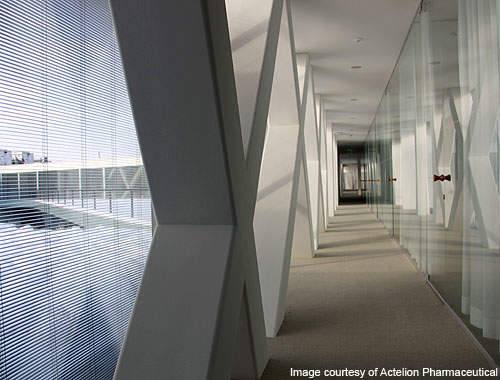In December 2010, global biopharmaceutical company Actelion Pharmaceuticals opened a new Business Center in Allschwil municipality near Basel, Switzerland. The project is a building designed on the theme of communication and openness.
The Actelion Business Center was designed by Herzog & de Meuron. Construction of the building was started in August 2007 and completed in December 2010 at a cost of CHF130m ($147.5m). The building has a gross floor area of 27,470m² and offers workspace for 350 employees. The company also plans to establish a research and development building in Bachgraben area in Allschwil.
The facility has an auditorium with a seating capacity for 120 people. The building also has a cafeteria, a 230 people capacity restaurant and 150 car parking spaces.
Design
The 80m x 80m x 21m building has six upper floors and two basement levels. The building has a total volume of 104,500m³.
The upper floors are cantilevered by stacking them atop of each other with open, angular steel structures. Open steel construction allowed the different blocks to jut out in different directions and have different layouts. All the floor modules meet at four points that connect the beams of the offices.
Strict regularity is maintained in these corner points for functionality. These core zones have staircases and elevators that provide access to the entire building. They have meeting and training rooms, kitchens and seating islands. The access points provide a natural communication-oriented atmosphere to employees.
Interior design
The open plan provides light-filled interiors. The room modules allow flexible usage of space and can be configured to single office units or offices for two people or manageable open plan offices. Privacy rooms are also present.
Ceilings and floors are laid with building installations such as pipes and ducts to create continuous openness. The building has a cross-shaped foyer. Reception area is located at the central point of the hall. The four open side wings house the auditorium, staff restaurant, cafeteria, conference rooms and a variable open space for events.
Structure
The cantilevering floors are made of five to seven prismatic building blocks. Each floor is different from the lower floors and has an individual structure. The structure that bears the building load is made up of about 3.8km-long steel frames. Floor plans were created with about 400m tall trusses and different angular inclinations.
The steel frame is divided into different sections based on the individual sections of the offices. All the linear offices have a varied façade due to the frame sections.
About 2,500t of steel was processed to create the framework. The steel bars are shaped as ‘X’, ‘K’ or straight depending on the static requirements. The steel is painted white and plastered for protection against fire. The white colour also emphasises the visual identity of the building. The four internal staircases required about 100t of steel and another 100t for a spatially disposed structure. The building also has 700t of composite beams as secondary support structures.
Sustainability
Despite the large volumes, the building has several sustainable features such as triple glazed glass windows, self-adjusting, reactive louvres and green roofs. The building uses a combination of natural gas, electrical and renewable energy to meet the cooling and heating demands. The design is targeted at conserving the resources and reducing carbon emissions.
The solid ceilings are thermally activated and all the offices feature separate controllable heat distribution equipment. Photovoltaic cells are arranged for partially generating electricity.
Façade
The floor-to-ceiling windows are made of triple-glazed glass to allow maximum natural light into the building. It creates transparency to the building and allows eye communication from upwards, downwards, inwards and outwards. The 15,020m² of façade area also features sun protection louvres.
The building is made self-shading by inclining the exposed façade surfaces of the upper floors to downwards. The shady lower surfaces are also inclined upwards.
Landscaping
The building has been landscaped with a mix of horsetail and ivy plantations around the entrance. Three interior carpets made of ivy, ferns and low-growing Anthurias and palms reach out to the exteriors to reduce the boundary differences.
The unplanted gravel areas will be landscaped with stonecrops. The sunny, stacked areas of the roofs are landscaped with prairie grass which changes their colour as per the seasons. Plant substrates are grown on the other rooftops.

